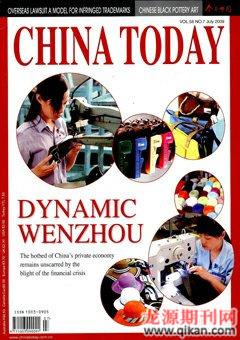Trade Organizations Show Collective Strength
LIU QIONG
IN China it is common that the company position of a businessperson is given a prime spot on their business card, but not in Wenzhou. Natives of this city reserve the conspicuous slot for their titles within an entire industry group, or guild. Guilds have shown themselves to be a vital structure for a booming local economy, and guild leaders are held in high esteem in the region. There are 34 such groups in Wenzhou at present, representing 20,000 or more enterprises, and covering all sectors of the local economy.

A Binding Force
Since he was elected chairman of the Wenzhou Fashion Association in 2006, Zheng Chenai, president of Zhejiang Aobenni Garments Co., Ltd., has had to set aside two thirds of his time for association affairs, but hes not complaining. “The association exists at the pleasure of the enterprises,” he said. In the early 1990s local garment manufacturers felt strongly that they should forge recognizable brands, in the hope they could change the national prejudice against the city as a workshop of shoddy and cheap togs. This is no easy task for any single enterprise. So nine companies founded a garment industry association, the first private one of its kind in China.
“The success of Wenzhous garment industry owes much to the association. Enterprises found they had more to gain than lose by bringing down the walls between them,” said Zheng. When Baoxiniao, another leading garment company in the city, inaugurated its new facility in 1998, its president opened it to counterparts in other companies of the trade, a move that counters the common sense notion of guarding against competitors. Wenzhou people sensibly regard the judgment of their crafts brethren as valuable advice on their own product lines.
With 2,500-plus garment companies generating a total production value in excess of RMB 40 billion, Wenzhou now has one of the most formidable garment industries in China. After Zheng Chenai took office, he conducted a six-month survey on association members, aiming to pinpoint aspects of performance where local garment enterprises have the best chance of challenging and bettering their rivals at home and abroad.

A Network of Information and Relationships
The three million people who run businesses out of Wenzhou are drivers behind a diaspora of approximately 170 Wenzhou chambers of commerce worldwide. “Wenzhou is small, so many people leave the city to seek broader markets,” said Wang Xinfu, vice president of the citys General Chamber of Commerce.
The first Wenzhou chamber of commerce established beyond the city limits took root in Kunming, Yunnan Province, in 1995, which had a community of 30,000 Wenzhou merchants at the time. These migrants organized themselves to better protect their rights and interests, spawning Wenzhous record numbers of chambers of commerce all over the world. As Mr. Wang put it, “Wherever there are people, there are Wenzhou businesspeople and their chambers of commerce.”
These organizations constitute an extensive network of market information and trade affinity, channeling business tips and assistance among their members. The magnitude of wealth and influence of Wenzhou natives has drawn the attention of local governments everywhere. In Shenyang for instance, over the past decade the municipal government and local Wenzhou chamber of commerce have co-sponsored several delegations to Wenzhou to court investors. The return on each trip has topped the initial RMB several billion, climbing to the latest figure of RMB 20 billion.
Investment on such a scale demands thorough due diligence and acute scrutiny, a matter a chamber of commerce can expedite. A Wenzhou entrepreneur recalled that it took him only a couple of days to reach a merger agreement involving RMB 70 million in Xinjiang. Before setting foot on the Uygur autonomous region in Chinas far west, he was already acquainted with every aspect of the project and his partners, including their hobbies and personalities – all from a local Wenzhou chamber of commerce.
United We Stand
Wang Xinfu emphasizes, “Chambers of commerce facilitate Wenzhou peoples successful competition in markets around the world. They assemble the local resources, enable mutual aid, and reduce costs and risks. ” During the 2006 MIDO Exhibition in Milan, an event spanning optical, optometry and eyewear sectors, the 80-odd Wenzhou exhibitors secured the booths close to the entrance and ended up with orders worth US $40 million, drawing admiration from their neighboring Jiangsu Province peers. Yang Xumai, vice secretary general of the Wenzhou Optical Association, confirmed that, as a group, his member companies were at an advantage in securing more and better space in the exhibition.
A united front also gives Wenzhou companies the means and resources to handle disputes in international trade. In 2002 the European Union brought an anti-dumping suit against Wenzhou lighter exporters. Accompanied by officials of the Ministry of Foreign Trade and Economic Cooperation (now Ministry of Commerce), three leaders of the Wenzhou Smoking Outfit Manufacturers Association conducted a tour to lobby EU member countries. They conferred with their standardization departments, consumers safety groups and lighter importers associations. This is the first time a Chinese civil trade group actively responded to charges from foreign buyers.
In 2003 the EU withdrew the case against Chinese metal-shelled lighters. Fighting the lawsuit cost roughly RMB 2 million – all of it raised by the Wenzhou association. President Zhou Dahu credited the victory to the leadership of the society. “Cases like this touch the reputation of an entire industry, and a single company may not find such a lone battle feasible. An association can bring all companies in a given sector together to fight as one. This particular case set a good example for other private companies in China.”

